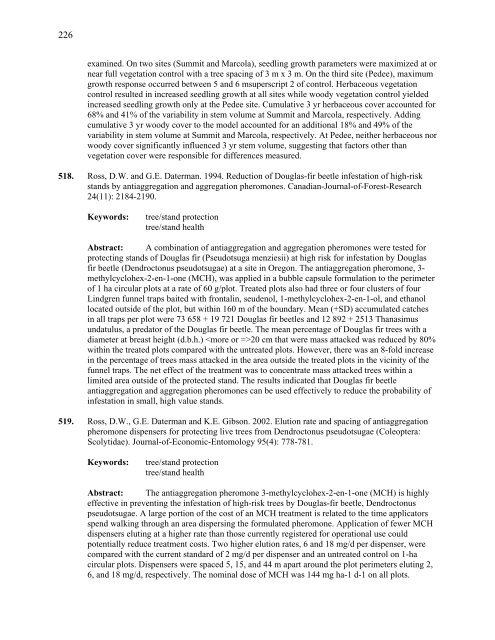IntensIve sIlvIculture - Forest Science Labs - Research Network ...
IntensIve sIlvIculture - Forest Science Labs - Research Network ...
IntensIve sIlvIculture - Forest Science Labs - Research Network ...
Create successful ePaper yourself
Turn your PDF publications into a flip-book with our unique Google optimized e-Paper software.
226<br />
examined. On two sites (Summit and Marcola), seedling growth parameters were maximized at or<br />
near full vegetation control with a tree spacing of 3 m x 3 m. On the third site (Pedee), maximum<br />
growth response occurred between 5 and 6 msuperscript 2 of control. Herbaceous vegetation<br />
control resulted in increased seedling growth at all sites while woody vegetation control yielded<br />
increased seedling growth only at the Pedee site. Cumulative 3 yr herbaceous cover accounted for<br />
68% and 41% of the variability in stem volume at Summit and Marcola, respectively. Adding<br />
cumulative 3 yr woody cover to the model accounted for an additional 18% and 49% of the<br />
variability in stem volume at Summit and Marcola, respectively. At Pedee, neither herbaceous nor<br />
woody cover significantly influenced 3 yr stem volume, suggesting that factors other than<br />
vegetation cover were responsible for differences measured.<br />
518. Ross, D.W. and G.E. Daterman. 1994. Reduction of Douglas-fir beetle infestation of high-risk<br />
stands by antiaggregation and aggregation pheromones. Canadian-Journal-of-<strong>Forest</strong>-<strong>Research</strong><br />
24(11): 2184-2190.<br />
Keywords: tree/stand protection<br />
tree/stand health<br />
Abstract: A combination of antiaggregation and aggregation pheromones were tested for<br />
protecting stands of Douglas fir (Pseudotsuga menziesii) at high risk for infestation by Douglas<br />
fir beetle (Dendroctonus pseudotsugae) at a site in Oregon. The antiaggregation pheromone, 3methylcyclohex-2-en-1-one<br />
(MCH), was applied in a bubble capsule formulation to the perimeter<br />
of 1 ha circular plots at a rate of 60 g/plot. Treated plots also had three or four clusters of four<br />
Lindgren funnel traps baited with frontalin, seudenol, 1-methylcyclohex-2-en-1-ol, and ethanol<br />
located outside of the plot, but within 160 m of the boundary. Mean (+SD) accumulated catches<br />
in all traps per plot were 73 658 + 19 721 Douglas fir beetles and 12 892 + 2513 Thanasimus<br />
undatulus, a predator of the Douglas fir beetle. The mean percentage of Douglas fir trees with a<br />
diameter at breast height (d.b.h.) 20 cm that were mass attacked was reduced by 80%<br />
within the treated plots compared with the untreated plots. However, there was an 8-fold increase<br />
in the percentage of trees mass attacked in the area outside the treated plots in the vicinity of the<br />
funnel traps. The net effect of the treatment was to concentrate mass attacked trees within a<br />
limited area outside of the protected stand. The results indicated that Douglas fir beetle<br />
antiaggregation and aggregation pheromones can be used effectively to reduce the probability of<br />
infestation in small, high value stands.<br />
519. Ross, D.W., G.E. Daterman and K.E. Gibson. 2002. Elution rate and spacing of antiaggregation<br />
pheromone dispensers for protecting live trees from Dendroctonus pseudotsugae (Coleoptera:<br />
Scolytidae). Journal-of-Economic-Entomology 95(4): 778-781.<br />
Keywords: tree/stand protection<br />
tree/stand health<br />
Abstract: The antiaggregation pheromone 3-methylcyclohex-2-en-1-one (MCH) is highly<br />
effective in preventing the infestation of high-risk trees by Douglas-fir beetle, Dendroctonus<br />
pseudotsugae. A large portion of the cost of an MCH treatment is related to the time applicators<br />
spend walking through an area dispersing the formulated pheromone. Application of fewer MCH<br />
dispensers eluting at a higher rate than those currently registered for operational use could<br />
potentially reduce treatment costs. Two higher elution rates, 6 and 18 mg/d per dispenser, were<br />
compared with the current standard of 2 mg/d per dispenser and an untreated control on 1-ha<br />
circular plots. Dispensers were spaced 5, 15, and 44 m apart around the plot perimeters eluting 2,<br />
6, and 18 mg/d, respectively. The nominal dose of MCH was 144 mg ha-1 d-1 on all plots.
















